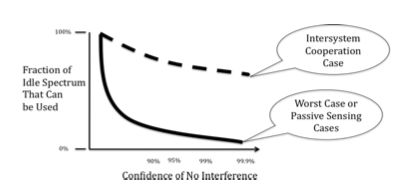2 Pragmatic Cognitive Radio Papers from DySPAN 2010

Thought I would share 2 pragmatic papers from the conference with readers. CR has the reputation of being a challenge in the face of the “spectrum haves” that will do them no good and possible/likely harm. Indeed many people believe that cognitive radio means lister-before-talk passive sensing of the spectrum to be used. They correctly point out that LBT will inevitably involve some sensing errors. However, opponents of CR usually ignore that high processing gain (the ratio of detector sensitivity to normal receiver sensitivity) and multiple site sensing can reduce error rate to arbitrarily low levels.
Let’s go back to Joe Mitola’s original 1998 definition of CR:
“The point in which wireless personal digital assistants (PDAs) and the related networks are sufficiently computationally intelligent about radio resources and related computer-to-computer communications to detect user communications needs as a function of use context, and to provide radio resources and wireless services most appropriate to those needs.”
Note, that the key point is “user communications needs as a function of use context” NOT LBT which is just one possible means to this end.
With that in mind you might wish to read the paper “Cognitive Radio, the Market and the Regulator” by Peter Anker, Technical University Delft. Abstract:
At the moment in a number of countries experiments with the use of cognitive radio are performed. However, there is a considerable degree of uncertainty regarding the potential application of cognitive radio. For successful use of cognitive radio, there is a need for cooperation between the technology developers, the market players and the regulator to reduce these uncertainties. In this contribution a proposal is made to make a more congruent approach towards the implementation of cognitive radio to lower these uncertainties to an acceptable level, with a special emphasis on the role of the regulator.
Your blogger’s paper entitled “Cognitive Radio Under Conservative Regulatory
Environments: Lessons Learned and Near Term Options” might also be of interest. Here is the abstract:
In recent regulatory decisions, spectrum regulators have been very conservative in permitting use of cognitive radio systems requiring large “safety margins”. This paper describes the nature of these safety margins and the factors that lead to them. New research that might counter such concerns is suggested. Cooperative approaches involving primary user systems that actively cooperate with cognitive users ad also suggested.
A key point is shown in the diagram below.

This shows the inverse relationship between fraction of idle spectrum that is used and confidence of no interference s well as the benefit of using intersystem cooperation vice passive sensing only.



![Validate my RSS feed [Valid RSS]](valid-rss-rogers.png)

